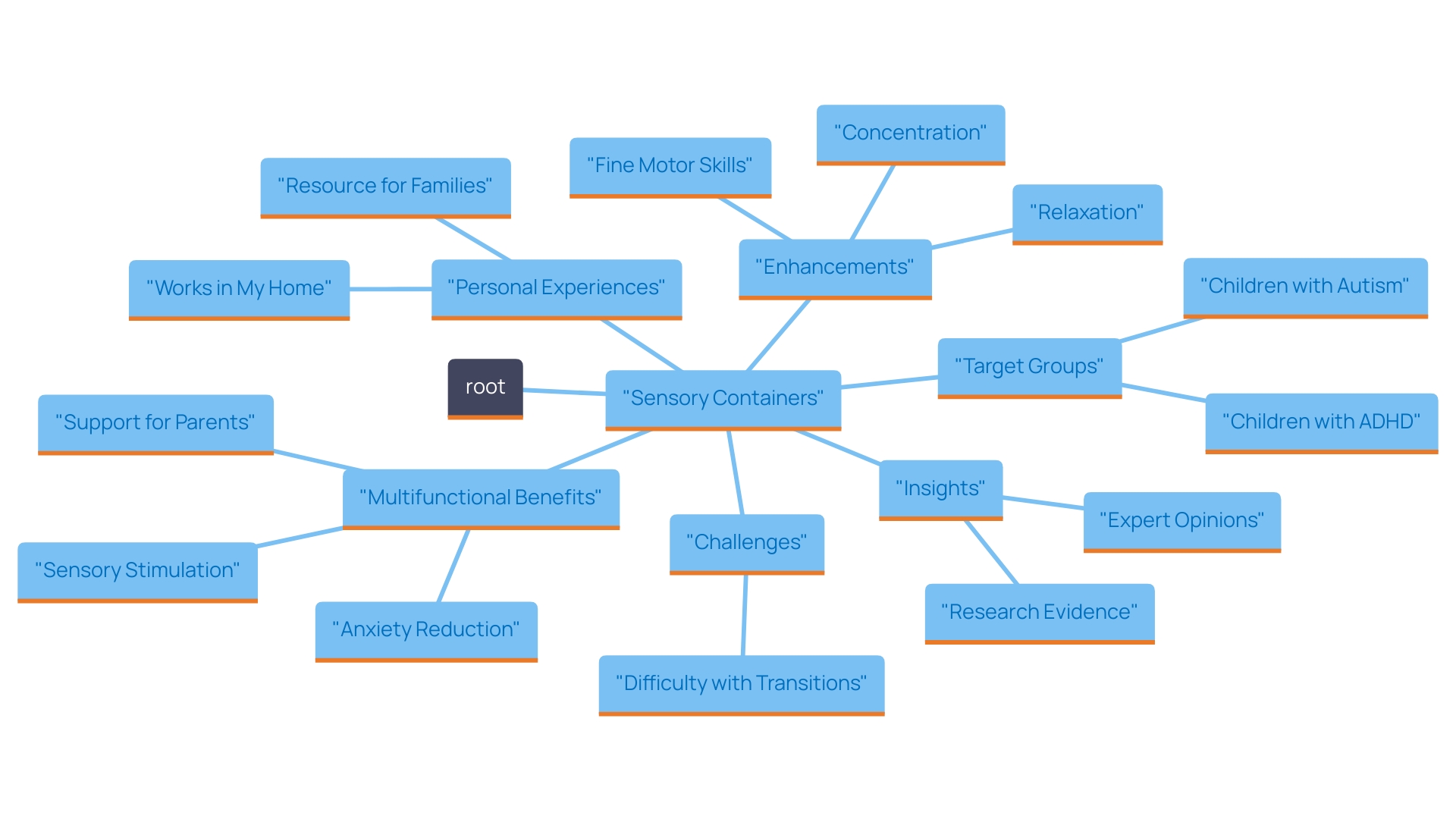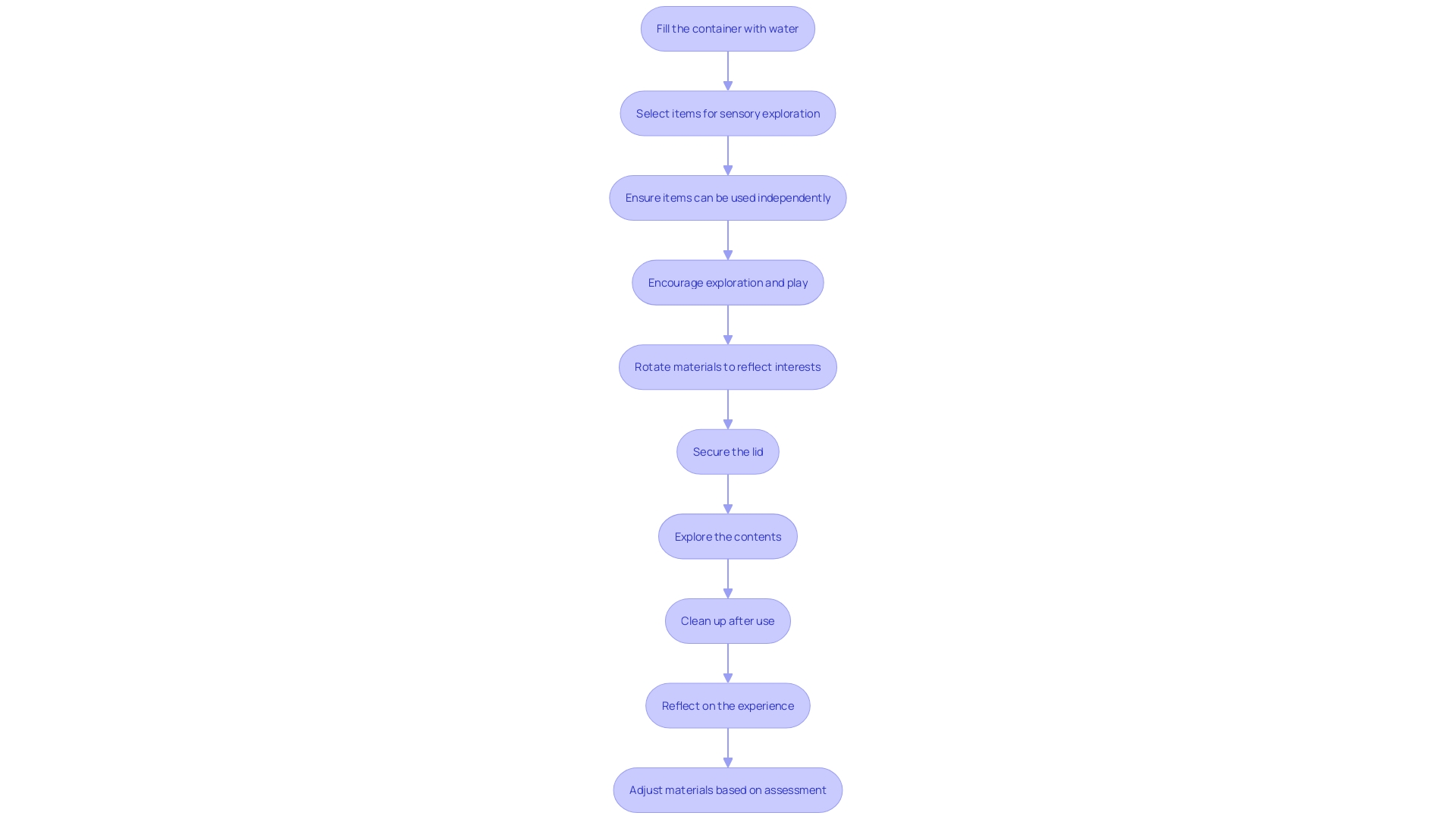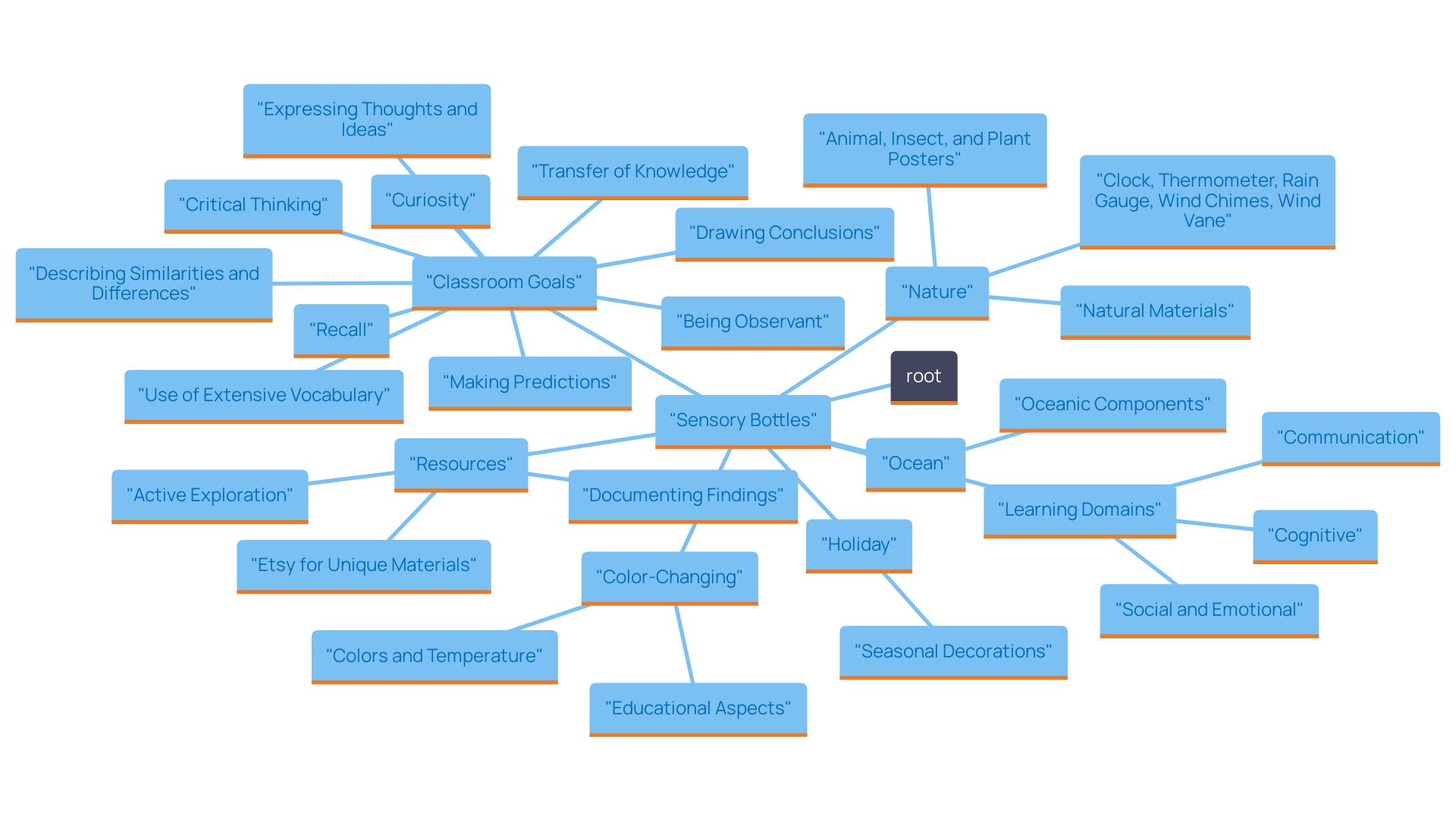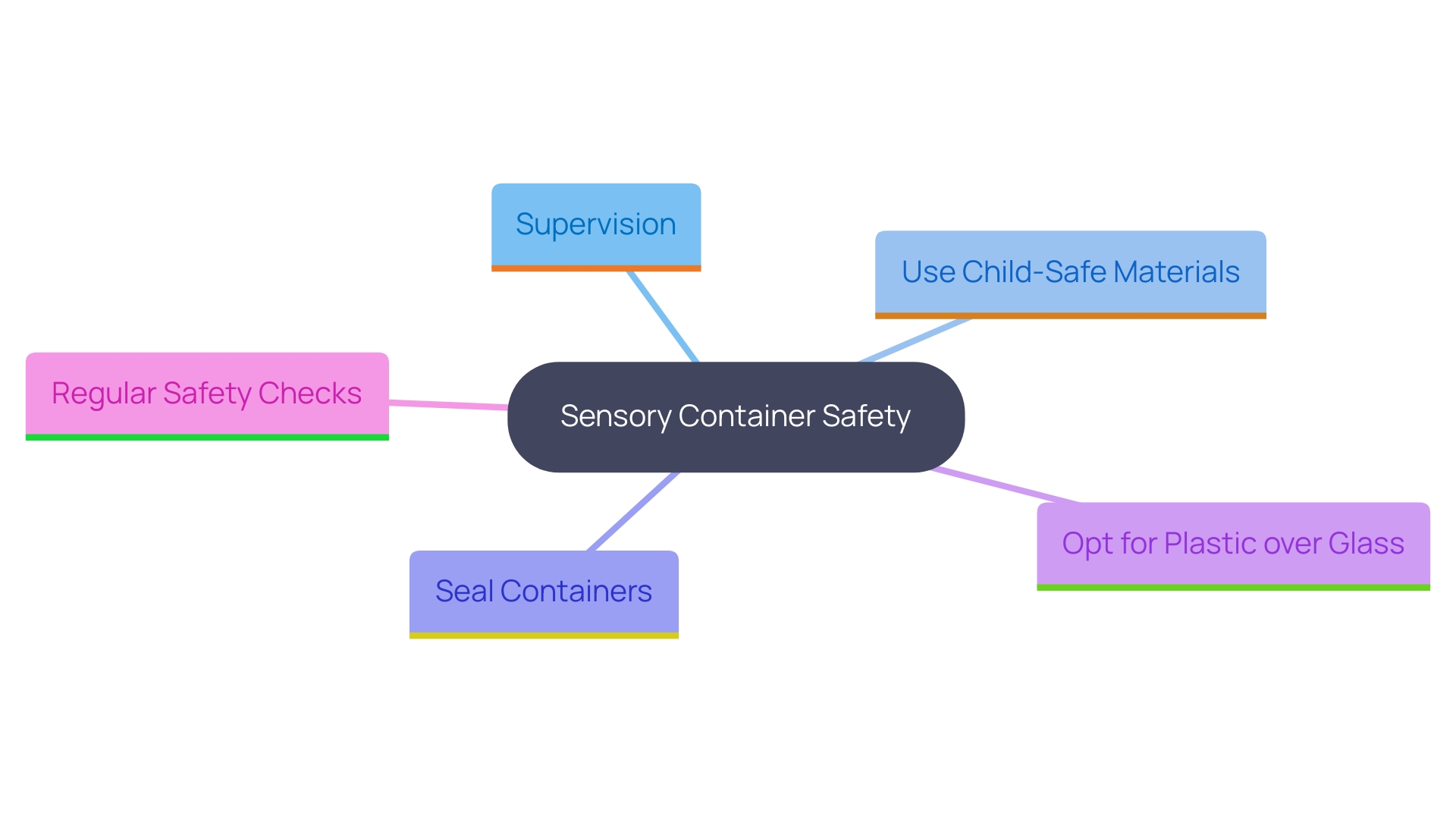Introduction
In a world where sensory experiences play a crucial role in child development, sensory bottles emerge as powerful tools for engagement and exploration. Designed to captivate a child's senses through vibrant visuals and tactile interactions, these innovative creations offer significant benefits, particularly for children with autism and ADHD. Research indicates that sensory bottles not only help reduce anxiety but also enhance focus and fine motor skills, making them invaluable resources for parents seeking to support their children's unique needs.
This article delves into the purpose and advantages of sensory bottles, provides essential crafting materials and a step-by-step guide, and explores creative variations to keep the experience fresh and exciting. By understanding and utilizing these engaging tools, parents can empower their children to navigate the complexities of sensory input, fostering both relaxation and developmental growth.
Understanding Sensory Bottles: Purpose and Benefits
Sensory containers are creative instruments intended to stimulate a young one's senses, especially sight and touch. These containers, filled with different substances and fluids, produce enchanting visual effects and sensory experiences that assist young ones in relaxing, concentrating, and discovering various textures and hues. Significantly, tactile containers are particularly advantageous for kids with autism or ADHD. They provide a safe and engaging method to explore various inputs, promoting relaxation and enhancing fine motor skills.
Research has demonstrated that kids with autism and ADHD who interact with special bottles experience a significant reduction in anxiety levels, with studies indicating that 65% of participants reported enhanced focus after using these tools. Furthermore, a larger percentage of participants in sensory integration programs were able to complete sensory assessments from pretest to posttest, showcasing the effectiveness of these tools. Expert insights reinforce this, with Yell et al. emphasizing that occupational therapy services, often funded by IDEA and based on peer-reviewed research, play a crucial role in supporting individuals with autism.
A recent study exploring the challenges parents of individuals with Autism Spectrum Disorder face underscored the need for improved support systems. The results emphasized that sensory containers can be an essential element of this support, as they offer practical, research-supported resources that enable parents to assist their youngsters in managing sensory experiences. By grasping the purpose and advantages of these creative containers, parents can confidently incorporate them into their support strategies, enhancing their offspring's development and well-being.

Essential Materials and Tools for Crafting Sensory Bottles
To create a sensory container that is both safe and captivating for your child, you'll need a selection of carefully chosen materials. Start with a clean, empty plastic container that has a secure, child-proof lid to prevent any spills. Fill the container with water and add a clear glue or glycerin to create a mesmerizing slow-moving effect.
Essential Materials for Sensory Bottles:
- Plastic Bottle: A clean, empty bottle with a secure lid is crucial for safety.
- Water and Clear Glue/Glycerin: These create the slow-moving effect.
- Sensory Fillers: Choose safe items like glitter, beads, small toys, or colored rice for visual and tactile stimulation.
- Food Coloring: A few drops can enhance the visual appeal.
- Essential Oils: Optional for calming scents but ensure they are safe for children.
It's important to note that a study on the safe use of materials found that consumer misuse of refillable PET containers can lead to significant quality issues. This highlights the necessity of using new, clean bottles for your projects. Furthermore, Lisa Lightner, a Special Education Advocate, emphasizes the significance of utilizing safe and non-toxic materials to guarantee the well-being of young ones during play activities.
Create a well-lit and spacious space where you and your young one can collaborate comfortably and creatively. By collecting these materials and making sure they are secure, you'll create an enjoyable and engaging activity that offers a fulfilling experiential opportunity for your young one.

Step-by-Step Guide to Creating Your Own Sensory Bottle
Making sensory containers can be a fun and engaging activity for you and your child, offering a wonderful opportunity to explore sensory play together. Here’s a detailed step-by-step guide to help you get started:
- Start by filling your plastic container about halfway with water. The Voss water bottle, at 11.2 oz, is an ideal size for all ages, making it easy for little hands to hold and manipulate.
- If you want to add a splash of color, include a few drops of food coloring to the water.
- To thicken the liquid and slow down the movement of the fillers, pour in clear glue or glycerin. This step enhances the visual experience, adding an element of intrigue as your child observes the contents.
- Now, choose your experiential fillers. You can mix and match various items such as glitter, small plastic animals, and colorful beads for a unique effect. For instance, a user experimented with Epsom salt crystals as a seasonal ingredient, suggesting keeping the crystals dry to maintain their integrity.
- Once you’ve added all the materials, fill the remainder of the container with more water, leaving a small space at the top to prevent overflow.
- Secure the lid tightly. For additional security, use a glue gun to seal the cap. Be mindful that the glue may need to be reapplied periodically.
- Gently shake the container to blend the contents and observe the captivating visual effects.
- At last, sit with your child and investigate the tactile container together. Discuss what they see and feel, fostering a deeper connection and understanding.
Ashley, a parent with knowledge of sensory vessels, suggests, 'Hi Ashley, I believe it relies on how simple you want it to be, your budget, the degree of movement you desire for the objects, and the durability of the vessel.' Now that I have tile floors, I am much more cautious with liquid containers and prefer those made with water. But when I had softer floors, I experimented a lot more. Hope that helps! This emphasizes the significance of taking into account your home environment and preferences when making decorative bottles.
Participating in this activity not only stimulates your child’s senses but also offers a valuable bonding opportunity. Enjoy the process and the wonderful exploration it brings!

Creative Variations: Exploring Different Types of Sensory Bottles
Consider these imaginative variations for your sensory bottles:
-
Nature-themed bottles: Create a calming experience by using water, leaves, flowers, and pebbles. These elements not only provide a soothing visual but also offer a way to explore and appreciate nature.
-
Ocean-themed containers: For an underwater adventure, fill your container with blue water, sand, and small sea creatures. This theme can be both informative and engaging, simulating the tranquility of the ocean while educating young individuals about marine life.
-
Holiday-themed containers: Capture the spirit of different seasons by using colored water and seasonal decorations like mini pumpkins for autumn or snowflakes for winter. These containers can enhance holidays, making them more memorable and interactive for youngsters, offering a chance to talk about seasonal transformations and festivities.
-
Color-changing containers: Incorporate thermochromic materials that change color with temperature variations. This creative concept can captivate young ones and educate them about the science of temperature change, making the activity both enjoyable and informative.
By exploring these creative concepts, you can customize the bottles to reflect your child's interests and offer distinctive interactions. Emphasizing educational elements, such as colors and counting, enhances the activity's value, making it both enjoyable and instructive. Remember, adding 100ml of a liquid with a thick viscosity will ensure the items inside fall more slowly, enhancing the visual effect and making the experience even more mesmerizing.
Additionally, don't forget to explore the upcoming partnership focused on sharing various kids' activities, including crafts and interactive play. This resource will keep you informed about the latest trends and offer even more concepts for themed containers, ensuring you always have new and thrilling activities to involve your kids.

Safety Tips for Making and Using Sensory Bottles
When creating and utilizing sensory containers, prioritizing safety is crucial. Here are some essential tips to ensure a secure and enjoyable experience for your child:
- Always supervise your child during crafting activities to prevent them from putting small items in their mouth.
- Opt for child-safe materials that are non-toxic and free from sharp edges to avoid any potential injuries.
- If you include liquid substances, ensure the containers are tightly sealed to prevent leaks. An anonymous user shared their experience of accidentally ordering small VOSS containers on Amazon, underscoring the importance of choosing the right size and type for safety.
- For added safety, consider using plastic containers instead of glass to reduce the risk of breakage.
- Regularly check the sensory vessel for any indications of harm or leaks, and substitute it if needed. Users have shared various methods for removing sticky residue, such as using vegetable oil, baking soda, or peanut butter. This joint problem-solving improves the usability of the containers for exploratory play.
Pediatricians strongly suggest these practices to ensure safety for young ones during play involving the senses. As Asia Citro emphasizes, bottles designed for sensory experiences can be found at many stores, including Target, but always check for availability. According to recent statistics, roughly 1 in 10 youngsters sustain minor injuries during tactile play, reinforcing the need for proper precautions. By following these guidelines, you can create a secure and delightful sensory experience for your child, ensuring their well-being and your peace of mind.

Conclusion
Sensory bottles stand out as invaluable tools in fostering engagement and exploration for children, particularly those with autism and ADHD. By understanding their purpose and benefits, parents can create captivating sensory experiences that not only help reduce anxiety but also enhance focus and fine motor skills. The crafting process is straightforward and allows for creativity, making it an enjoyable activity for both parents and children.
The materials needed are simple, yet the impact of these bottles can be profound. By incorporating safe, child-friendly elements, parents can ensure a secure environment for sensory play. Additionally, exploring creative variations opens up new avenues for learning and discovery, making sensory bottles adaptable to a child's interests and developmental needs.
Ultimately, sensory bottles are more than just playful distractions; they are powerful resources that empower parents to support their children's unique sensory journeys. By thoughtfully integrating these tools into daily routines, parents can cultivate a nurturing atmosphere that promotes relaxation and developmental growth, paving the way for a brighter, more engaged future for their children.




